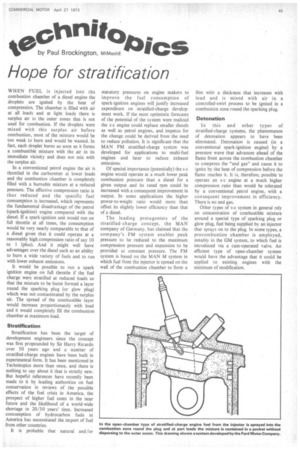te einit0 by Paul Brockington, MIMeehE
Page 47

If you've noticed an error in this article please click here to report it so we can fix it.
Hope for stratification
WHEN FUEL is injected into the combustion chamber of a diesel engine the droplets are ignited by the heat of compression. The chamber is filled with air at all loads and at light loads there is surplus air in the outer zones that is not used for combustion. If the droplets were mixed with this surplus air before combustion, most of the mixture would be too weak to burn and would be wasted. In fact, each droplet burns as soon as it forms a combustible mixture with the air in its immediate vicinity and does not mix with the surplus air.
In a conventional petrol engine the air is throttled in the carburetter at lower loads and the combustion chamber is completely filled with a burnable mixture at a reduced pressure. The effective compression ratio is thus reduced and the specific fuel consumption is increased, which represents the fundamental disadvantage of the petrol (spark-ignition) engine compared with the diesel. If a spark-ignition unit would run on full throttle at all times, the consumption would be very nearly comparable to that of a diesel given that it could operate at a reasonably high. compression ratio of say 10 to 1 (plus). And it might well have advantages over the diesel such as an ability to burn a wide variety of fuels and to run with lower exhaust emissions.
It would be possible to run a spark ignition engine on full throttle if the fuel charge were stratified at reduced loads so that the mixture to be burnt formed a layer round the sparking plug (or glow plug) which was not contaminated by the surplus air. The spread of the combustible layer would increase proportionately with load and it would completely fill the combustion chamber at maximum load.
Stratification Stratification has been the target of development engineers since the concept was first propounded by Sir Harry Ricardo over 50 years ago and a number of stratified-charge engines have been built in experimental form. It has been mentioned in Technitopics more than once, and there is nothing to say about it that is strictly new. But hopeful references have recently been made to it by leading authorities on fuel conservation in reviews of the possible effects of the fuel crisis in America, the prospect of higher fuel costs in the near future and the likelihood of a world-wide shortage in 20/30 years' time. Increased consumption of hydrocarbon fuels in America has necessitated the import of fuel from other countries.
It is probable that natural and/or statutory pressures on engine makers to improve the fuel consumption of spark-ignition engines will justify increased expenditure on stratified-charge development work. If the most optimistic forecasts of the potential of the system were realized the s-c engine could replace smaller diesels as well as petrol engines, and impetus for the change could be derived from the need to reduce pollution. It is significant that the MAN FM stratified-charge system was developed for applications to multi-fuel engines and later to reduce exhaust emissions.
Of special importance (potentially) the s-c engine would operate at a much lower peak combustion pressure than a diesel for a given output and its rated rpm could be increased with a consequent improvement in output. In some applications the higher power-to-weight ratio would more than offset its slightly lower efficiency than that of a diesel.
The leading protagonists of the stratified-charge concept, the MAN company of Germany, has claimed that the company's FM system enables peak pressure to be reduced to the maximum compression pressure and expansion to be provided at constant pressure. The FM system is based on the MAN M system in which fuel from the injector is spread on the wall of the combustion chamber to form a film with a thickness that increases with load and is mixed with air in a controlled-swirl process to be ignited in a combustion zone round the sparking plug.
Detonation In this and other -types of stratified-charge systems, the phenomenon of detonation appears to have been eliminated. Detonation is caused (in a conventional spark-ignition engine) by a pressure wave that advances ahead of the flame front across the combustion chamber to compress the "end gas" and cause it to ignite by the heat of compression before the flame reaches it. It is, therefore, possible to operate an s-c engine at a much higher compression ratio than would be tolerated by a conventional petrol engine, with a consequent improvement in efficiency. There is no end gas.
Other types of s-c system in general rely on concentration of combustible mixture around a special type of sparking plug or glow plug, fuel being supplied by an injector that sprays on to the plug. In some types, a precombustion chamber is employed, notably in the GM system, to which fuel is introduced via a cam-operated valve. An efficient type of open-chamber system would have the advantage that it could be applied to existing engines with the minimum of modification.












































































































